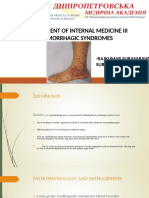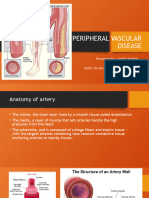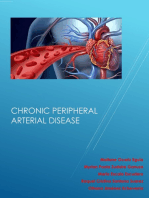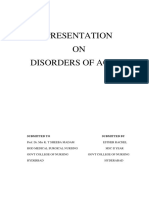Vasculitis: ANCA Associated
Vasculitis: ANCA Associated
Uploaded by
Mahda Adil AufaCopyright:
Available Formats
Vasculitis: ANCA Associated
Vasculitis: ANCA Associated
Uploaded by
Mahda Adil AufaOriginal Title
Copyright
Available Formats
Share this document
Did you find this document useful?
Is this content inappropriate?
Copyright:
Available Formats
Vasculitis: ANCA Associated
Vasculitis: ANCA Associated
Uploaded by
Mahda Adil AufaCopyright:
Available Formats
VASCULITIS
DEFINITION Vasculitis is a heterogeneous group of diseases, which are relatively uncommon. They are
characterized by inflammatory cell infiltration and necrosis of the blood vessels walls and this leads to organ dysfunction. Blood vessels are the focus of inflammatory attack, which usually result in the destruction of the vessel wall. It is important to exclude cases where perivascular cuffing of inflammatory cells is the only abnormality detected on histology.
EPIDEMIOLOGY These disease are relatively rare and affect both sexes.
CLASSIFICATION The classification of vasculitis is confusing due to considerable overlap and heterogeneity between the different vasculitic syndromes and also because the exact etiopathogenesis is as yet unknown.
The American College of Rheumatology has now published criteria for classification of vasculitis. These criteria are laid down to help identify those specific clinical findings that separate each vasculitic syndrome from the other, and provide a standard way of evaluating and describing groups of patients in therapeutic, epidemiological or other studies.
Vasculitis Classification (Alpern 1995) Large vessel
Giant cell arteritis Takayasus arteritis
Medium vessel
Polyarteritis (classic)
Small vessel
nodosa 1. ANCA associated Wegeners granulomatosis Churg-Strauss syndrome Microscopic polyangiitis (microscopic PAN) Idiopathic pauci-immune
2.
Crescentic glomerulonephritis
Immune-complec associated Henoch Schonlein purpura Essential cryoglobulinemia Cutaneous leucocytoclastic angiitis Idiopathic immune-complex Crescentic glomerulonephritis Anti-GBM associated Anti-GBM disease
3.
Classification of primary systemic vasculitides (Chapel Hill Consensus Conference 1994)
Size of dominant Vessel affected Large Medium
Granulomatoua Temporal arteritis Takayasu arteritis
Non-grandulomatous
Small
Wegeners granulomatosis Churg-Strauss Syndrome
Classic polyarteritis nodosa Kawasaki disease Microscopic polyangiitis Henoch-Schonlein purpura Cutaneous leucocytoclastic vasculitis Essential cryoglobulinaemia vasculitis
CLINICAL PROFILE OF MAJOR GROUPS
1.
Severe systemic necrotising vasculitis, for example a) Polyarteritis nodosa (PAN) b) Chung-Strauss syndrome (CSS)
c) Wegeners granulomatosis (WG) Besides constitutional symptoms like fever, night sweats and weight loss, other characteristic features include mononeuritis multiplex, gastrointestinal bleeding, abdominal pain, cutaneous necrotic vasculitic lesions, nodular skin lesions, transient pulmonary infiltrates with or without hemoptysis, glomerulopathies and arthralgias. These may be progressive and life threatening.
2.
Large vesel vasculitis, for example a) Giant cell arteritis b) Takayasus arteritis Clinical characteristics include: Visual disturbances Headache and/or scalp tenderness Dizziness Transient ischemic attacks Upper limb claudication Myoarthralgias Kidneys and lungs are rarely involved in large vessel vasculitis unlike the previous group of vasculitic syndromes.
3.
Leucocytoclastic vasculitis (LCV) (cutaneous vasculitic syndrome), for example a) Acute LCV b) Chronic LCV c) Henoch-Schonlein purpura d) Acute hemorrhagic oedema of infancy
A few of the above types of vasculitis are discussed briefly below:
1.
Polyarteritis nodosa
Polyarteritis nodosa (PAN) is a systemic disorder where necrotising inflammation of medium sized arteries causes the formation of aneurysms. This condition tends to be progressive and may be fatal. The disease is predominantly seen in middle aged men, with either abrupt or gradual onset.
Although this disease may affect any organ of the body, the most commonly involved organs are the skin, joints, peripheral nerves, intestinal tract and kidneys. The lungs are usually not involved. The severity of the disease can vary from mild, limited disease to a fulminating one.
The presenting features in classical polyarteritis nodosa are often in the form of fever, malaise and weight loss. Arthralgias are present in 60% of cases, with synovitis less commonly observed. The skin involvement could present as ulcers of varying sizes, palpable purpura, ischemic changes of the distal digits, or livedo reticularis.
Peripheral neuropathy presents as mononeuritis multiplex.is an important feature, and are present in about 40% of patients.Features such as seizures and hemiparesis may indicate CNS involvement, but this is not as common as the peripheral nerve involvement; both might however appear together. Myalgia is a prominent symptom. The gastrointestinal tract may be frequently involved, with abdominal pain, gut infarction, bleeding and pancreatitis being the presenting features. Reno-vascular hypertension is caused by segmental necrotising glomerulonephritis and vascular nephropathy is observed in PAN.
Cardiac involvement may present as myocardial infarction or congestive cardiac failure.
Lung involvement occurs occasionally and may be in the form of diffuse infiltrations.
2.
Churg-Strauss syndrome This relatively uncommon condition occurs in patients with asthma or with a history of allergy. It is commonly seen in middle age, with men more often affected than women. Fever, malaise and weight loss are often the early manifestations. In the early stages, the
allergic symptoms like asthma worsen; this is then followed by eosinophilia and ultimately by vasculitis. With the development of the vasculitis, the asthma may abate. Multiple mononeuropathies are commonly present. Cutaneous manifestations may be in the form of subcutaneous nodules, petechiae, ulcerations or purpura. Cardiac involvement is common and present as congestive heart failure. Abdominal symptoms like diarrhoea, pain or infarction of abdominal organs are seen in a few patients. The renal involvement tends to be less severe as in PAN.
3.
Wegeners granulomatosis This condition is uncommon and occurs in young and middle aged adults, with a slight male predominance. The vessels mainly involved in this disease are the small arteries and veins. Necrotizing granulomatous lesions of the respiratory tract, focal segmental glomerulonephritis and vasculitis of other organs characterizes this condition.
Presenting features include non-specific findings such as fever, weight loss, myalgias, arthralgias, malaise and chronic rhinitis or sinusitis. Supportive otitis, mastoiditis, hearing loss and a saddle-nose defect may occur.
Lung involvement may be asymptomatic or presents as cough, pleuritic chest pain, dyspnoea, bloody or purulent sputum and hemorrhage. X-ray of the chest may show pulmonary infiltrates that may be transient or asymptomatic. X-ray findings may be incidental. Cavities may be observed, but pleural effusion occurs rarely. Tracheal lesions, especially stenosis, may also occur.
Kidney involvement is usually a late finding but with eventual manifestation being as high as 85% of cases. It presents in the form of proteinuria, hematuria, red blood cell casts or renal insufficiency.
Cutaneous findings include purpura, ulcerations or nodules.
Cranial nerve deficits include: cerebral vasculitis, multiple mononeuropathic and a symmetric polyneuropathy.
Artritis is usually transient and not frequently found.
Ocular involvement may present as episcleritis, scleritis, proptosis, uveitis, conjunctivitis, with less commonly corneal ulcerations, optic neuritis and retinal vasculitis.
4.
Giant cell arteritis Giant cell arteritis also known as cranial arteritis or temporal arteritis, is usually seen in individuals over 50 years of age. The onset is usually gradual but may be abrupt rarely. Presenting features include malaise, fever, fatigue and weight loss, with headaches, tenderness of the scalp particularly over the temporal arteries, visual loss, diplopia, jaw claudication and aortic arch syndrome being the more common manifestations. On examination the temporal arteries may be tender, thickened and erythemateous. The visual loss is usually abrupt and painless and may vary from a partial deficit of one eye to complete blindness in both eyes. In such patients, the examination of the eye may show ischemic retinopathy in the initial stages and optic atrophy after several weeks.
Involvement of skin, kidneys, lungs and intracranial vessels occur rarely. Peripheral neuropathy may be seen in a few patients.
5.
Takayasus arteritis Takayasus arteritis is a chronic vasculitis of the aorta and its branches, commonly involving more the proximal part of the aorta, but any part of the aorta may be involved. It is common in young women with the usual onset starting before the age of 40 years. Malaise and arthralgias are frequently seen in the early stage and mild synovitis may be seen. As the disease progresses, after weeks or months, symptoms and signs of vascular insufficiency are seen, such as coldness, or claudication of one or more limbs, dizziness, headaches, diplopia or sudden blindness in one eye, angina prectoris. Hypertension may also be present.
DIAGNOSIS The diagnosis of systemic vasculitis should be made by recognition of certain specific clinical pattern of vasculitis supported by investigations aimed at detecting the underlying etiology, anatomical extent of disease and physiological effect on organ-system dysfunction. Combinations of clinical features that are particularly suggestive of systemic vasculitis include: Rash with palpable purpura Peripheral neuropath Glomerulonephritis Evidence of regional ischemia like vasculitic ulcers and gangrene or Stroke in the young.
Clinical conditions that may mimic vasculitis are: Sepsis Multi-focal atheroemboli Malignancy (lymphoma) Antiphospholipid antibody syndrome Intravenous drug abuse or chronic poisoning.
Confirmatory test for vasculitis includes tissue documentation by biopsy (from symptomatic and accessible tissue, as well as) or clear angiographic evidence of vasculitis.
Sensitivity of confirmatory tests for systemic Necrotizing vasculitis Test Muscle biopsy Symptomatic or abnormal electromyographic 33-66 result Sural nerve biopsy Symptomatic or abnormal electromyographic Up to 75 Result Sensitivity
Percutaneous renal biopsy Nasal mucosa biopsy Testicular biopsy sympotomatic Liver biopsy
13-100 20-55
Up to 69
0-7 Visceral angiography 83-89
Angiography is useful in patients with suspected systemic vasculitis if symptoms and laboratory abnormalities do not direct the choice of biopsy. The typical angiographic appearance includes long segments of smooth arterial stenosis alternating with areas of dilatations, smooth tapered occlusions and absence of plaques or ulcerations. Such evidences are commonest in renal or hepatic circulation and less common in mesenteric vessels. However, visceral angiograms do not permit distinction between various vasculitic syndromes.
Antineutrophil cytoplasmic antibody (ANCA) may be either directed against a serine proteinase (proteinase 3) of the alpha granules of neutrophils producing cytoplasmic pattern of immunoflourescence due to antibodies against myeloperozidase (alcohol fixation artefact where these antigens migrate to perinuclear area during the process of fization). ANCA was originaly reported to be specific for Wegeners granulomatosis, but later it has also been found in other systemic vasculitides, especially those with renal involvement. IgM ANCA has been detected in despite treatment are associated with risk of relapse and thus serial measurement are particularly useful. Specificity of this antibody is also important. Diffuse or cANCA indicates activity of the antibody to a number of neutrophilic antigens including proteinase and this pattern of staining is most commonly seen in Wegeners granulomatosis. cANCA has also been described in few patients with rheumatoid vasculitis especially with severe systemic disease. Perinuclear staining pANCA also occurs in Wegeners granulomatosis and other vasculitides, especially those with disease limited to kidney (microscopic PAN) and more rarely SLE, Churg-Strauss vasculitis and adult HenochSchonlein purpura. In exceptional cases,the presence of cANCA may render tissue biopsy
unnecessary, particularly if the clinical features strongly support the diagnosis of Wegeners granulomatosis.
ASSESSMENT Relapses and remission are characteristics of the vasculitides group of systemic diseases. Disease indices must be identified to enable active phase management and to differentiate from drug related toxicity or infections.
Clinical assessment is the best objective guide for disease activity in vasculitis, preferably in conjunction with a validated scoring system.
Laboratory markers suggestive of active vascilitis 1. Hematology 2. 3. 4. Decreased hemoglobin Increased leucocytes, platelets, eosinophils Increased ESR, plasma viscosity Cryoglobulin screening
Biochemistry Increased urea, creatinine Deranged liver function test Increased CRP, von Willebrand factor
Urine Proteinuria Hematuria Granular and cell casts
Immunology Antinuclear factor (ANF), rheumatoid factor (RF) Increased IgG (Polyclonal) Rising ANCA titers or conversion from ANCA negative to ANCA positive Serum IL-2 receptor assay Anti GBM (Anti glomerular basement membrane) antibody 9
5.
Serology Hepatitis B & C, HIV antibody
Combination of all phase indices and scoring systems corroborated with clinical acumen should complement each other in monitoring disease activity in different subsets of vasculitis.
MANAGEMENT Prior to the era of immunosuppressive therapy, mortality in vasculitides was unacceptably high. However, over the past few years, the therapeutic outcome in different categories of vasculitis has remarkably improved.
1.
Leucocytoclastic vasculitis (LCV) Patients with small vessel vasculitis (SMV) often do not need treatment because the disease is usually self-limited. Good monitoring of patients and treatment with prednisolone (1mg/kg bodyweight) and other immunosuppressive therapy may be indicated if the symptoms persist. After resolution of skin lesions, a slow tapering of prednisone over 4 to 8 weeks period should be attempted. 2. Small and medium vessel vasculitis Polyarteritis nodosa (PAN) Churg-Strauss syndrome (CSS) Microscopic polyangiitis (MPA)
Polyarteritis nodosa: Untreated PAN has a 5 year mortality of greater than 85%. The survival rate improves to forty eight percent with steroids alone and eighty percent with combined steroids and immunosuppressive therapy.
Initially, corticosteroids are the treatment of choice, provided there are no signs of critical organ ischemia, but if deterioration occurs or if there is organ-system involvement, a cytotoxic agent is started. The debate continues regarding use of once monthly pulse cyclophosphamide (CPM) (15mg-20mg/kg) compared to oral daily cyclophosphamide (2mg/kg), Pulse therapy allows a lower cumulative dose to be given and exposes the patient to potential toxicity for shorter periods. Although the frequency of initial
10
improvement with pulse CPM therapy is encouraging, it is also associated with an increased relapse rate. High dose intravenous steroids (methylprednisolone 5001000mg/d) for initial three days may be used to treat severely ill patients for rapid control of disease in the initial phase before switching over to oral therapy. Unlike Wegeners granulomatosis, relapses in PAN are rare in patients who have recovered completely. The 10 year survival rate approaches 80%. Disease related deaths account for 40-50% of deaths observed in these patients.
Churg-Strauss syndrome (CSS):
Treatment of CSS is similar to PAN but more
scrupulous use of immunosuppressives like cyclophosphamide is needed. Although there is some overlap in features of PAN and CSS, these systemic necrotizing vasculitides differ significantly in response to therapy and in prognosis. Patients of CSS fare very well with corticosteroid therapy alone leading to rapid remission of disease. Thus, immunosuppressive therapy should be only reserved for treatment failure or relapse. It is quite often impossible to terminate steroids because of the residual asthma, which warrants low dose maintenance steroid therapy.
Microscopic polyarteritis: The initial phase of treatment is similar to that of PAN with high dose steroid and pulse cyclophosphamide. The use of azathioprine has been found to be of value in maintenance of remission in MPA. Clinical presentation of fulminant MPA is usually pulmonary renal failure and these patients need frequent plasma exchanges and adequate organ supportive care. The high relapse rate that is observed in patients with MPA may justify prolonged use of steroids or maintenance immunosuppressive therapy in these groups of patients.
Wegeners granulomatosis (WG): Treatment consists of three phases: a) Induction of remission b) Maintenance of remission c) Treatment of relapse Glucosteroid therapy, cyclophosphamide, azathioprine, methotrexate are the commonly used drugs for initiation, maintenance therapy and treatment relapse.
11
Glucosteroids have increased the mean survival of WG from about 5 to 12 months. Dramatic improvement in outcome may occur with the use of combination of glucocorticoids and cytotoxics, especially cyclophosphamide (CPM). This combination consists of prednisolone 1mg/kg/d and oral cyclophosphamide 2mg/kg/d. Prednisolone is tapered rapidly over first few months and cyclophosphamide is gradually tapered after one year in patients who have achieved remission. Without therapy the one-year mortality rate is 90%, 50% with corticosteroid therapy and 10% with combined steroids and cytotoxic drugs. The efficacy of steroids with daily oral CPM has been demonstrated in NIH study (n=148) which showed that 91% of patients on this protocol markedly improved and 75% achieved remission over a mean follow up period of approximately eight years (range 6 months to 24 years). Relapses occurred in 86% and treatment related morbidity in 42%. The overall disease related or treatment related mortality was 13% over 8 years.
Studies of pulse CPM therapy for WG show variable degrees of initial efficacy, followed by higher relapse rate than noted for patients receiving daily oral CPM. However the long-term toxicity of daily oral CPM is substantial.
Wegeners granulomatosis is a disease characterized by serious and frequent relapse, with a probable cause being an initiating or perpetuating bacterial or viral infection, with the role of Staphylococcus aureus being prominent.
Due to the high level of toxicity associated with the use of cyclophosphamide, less toxic drug like methotrexate in WG have been investigated. Methotrexate was similar to that for CPM while toxicity was much less. However, relapse rates were 48% over two years following dose reduction, which is comparable to that of CPM. Hence, Methotrexate may be considered as a reasonable option in patients without immediate life threatening disease who do not respond to or develop toxicity from CPM. Azathioprine (2mg/kg) is also a therapeutic option when CPM is not well tolerated, but it is less effective than CPM.
12
3.
Large vessel vasculitis/giant cell arteritis (GCA) Prednisone (1mg/kg/day) is highly effective in treating this disease. Dramatic response occurs within 48 hours of initiation of treatment and patients usually become symptomfree within two to four weeks allowing slow tapering of steroids thereafter. Starting treatment with steroids early, prevent visual loss. The disease activity and therapeutic response is measured by clinical follow-up and periodic ESR estimation. The duration of therapy may last up to twelve months while tapering the dose in view of a frequent relapse.
Non-specific aorto-arteritis/Takayasus arteritis (TA): TA promptly responds to high dose of steroids (prednisone approximately 1mg/kg/d). Unfortunately, 50% of patients relapse after tapering of prednisone therapy. Studies have shown that occasional TA patients may achieve remission with the use of CPM, azathiprine or methotrexate in addition to Prednisone. In critically stenotic lesions, surgical reconstruction/bypass or angioplasty may be required. Surgical revascularization may be necessary in patients with renovascular hypertension or ischemic symptoms. Percutaneous transluminal angioplasty has been successfully used to reopen occluded vessels. Long-term relief has been reported with graft bypass of occlusions or aneurysms.
ADDITION THERAPEUTIC MODALITIES
Cyclosporine (CSA) has been used in a few vasculitides like WG, where there has been poor response to other cytotoxics or in patients with intolerable side effects or poor bone marrow function. There is however a high chance of renal dysfunction.
Cytokine related therapies have also been tried (e.g. interleukin-1, interleukin-2, tumor necrosis factor), but these agents do not achieve cure and only help minimize exposure to cytotoxic drugs.
Immunoglobulins have been widely used in a number of vasculitides (e.g. WG and MPA), mostly in patients who have failed conventional treatment. In some patients there have been promising results in achieving induction and maintenance of remission with reduced requirement of
13
immunosuppressive drugs. A combination of aspirin in the dose range 100mg/kg/d for two weeks followed by 3-5mg/kg for six weeks with high dose immunoglobulin (2g/kg) as a single infusion is very effective in Kawasakis disease in children under 5 years of age to reduce symptoms as well as reducing the risk of subsequent coronary aneurysms.
CONCLUSION Systemic vasculitis can be a highly morbid and even fatal disorder, which required logical, systematic, often risky diagnostic and therapeutic procedures. A spectrum of clinical findings is present in the different types of vasculitis. If vasculitits is suspected, evaluation must be expedient and therapy often empirical with long term follows up to achieve sustained remission. In cases of clinical deterioration, it is difficult to distinguish between drug toxicity, infection or disease severity. Long-term survivorship is now a reality in this disorder, which was once considered uniformly fatal. However, the cost of treatment in terms of morbidity is rather high.
14
You might also like
- Vasculitis: Ameen Kabaha, MD Wolfson Medical Center100% (1)Vasculitis: Ameen Kabaha, MD Wolfson Medical Center68 pages
- Clinical Manifestations and Diagnosis of Systemic Sclerosis (No ratings yetClinical Manifestations and Diagnosis of Systemic Sclerosis (30 pages
- Department of Internal Medicine Iii Hemorrhagic Syndromes: - Rajkumar Subasaravanan Subgroup "12"No ratings yetDepartment of Internal Medicine Iii Hemorrhagic Syndromes: - Rajkumar Subasaravanan Subgroup "12"122 pages
- General Presentation of The Vasculitides: August 2010No ratings yetGeneral Presentation of The Vasculitides: August 20108 pages
- Connective Tissue Disorders: DR Josephine Ojoo MBCHB FRCP CCST (Resp) Dip Hiv Med Senior Lecturer Maseno UniversityNo ratings yetConnective Tissue Disorders: DR Josephine Ojoo MBCHB FRCP CCST (Resp) Dip Hiv Med Senior Lecturer Maseno University70 pages
- Thromboangiitis Obliterans Buerger's DiseaseNo ratings yetThromboangiitis Obliterans Buerger's Disease15 pages
- Classification of and Approach To The Vasculitides in Adult1No ratings yetClassification of and Approach To The Vasculitides in Adult116 pages
- Acute Rheumatic Fever - Clinical Manifestations and Diagnosis - UpToDateNo ratings yetAcute Rheumatic Fever - Clinical Manifestations and Diagnosis - UpToDate15 pages
- 15: Peripheral Vascular Disease: Patient Evaluation The Vascular DiseasesNo ratings yet15: Peripheral Vascular Disease: Patient Evaluation The Vascular Diseases15 pages
- Comprehensive Insights into Acute Arterial Occlusion: Pathways, Prevention, and Holistic CareFrom EverandComprehensive Insights into Acute Arterial Occlusion: Pathways, Prevention, and Holistic CareNo ratings yet
- 2022 American College of Rheumatology EULARNo ratings yet2022 American College of Rheumatology EULAR8 pages
- Recomendaciones EULAR Vasculitis Grandes VasosNo ratings yetRecomendaciones EULAR Vasculitis Grandes Vasos7 pages
- Diseases of Arteries - Arterial OcclusionNo ratings yetDiseases of Arteries - Arterial Occlusion377 pages
- Cardiovascula R Imaging: Dept. of Diagnostic Radiology Diponegoro Univ./Dr - Kariadi General HospitalNo ratings yetCardiovascula R Imaging: Dept. of Diagnostic Radiology Diponegoro Univ./Dr - Kariadi General Hospital85 pages
- PDF The Stroke Book 2nd Edition Michel T. Torbey Download100% (2)PDF The Stroke Book 2nd Edition Michel T. Torbey Download84 pages
- Unit Exam #1: Blood Vessels: B.) Advanced Glycation End ProductsNo ratings yetUnit Exam #1: Blood Vessels: B.) Advanced Glycation End Products85 pages
- (Mebooksfree - Net) Cas Stu Int Med 1stNo ratings yet(Mebooksfree - Net) Cas Stu Int Med 1st159 pages
- Vasculitis: Ameen Kabaha, MD Wolfson Medical CenterVasculitis: Ameen Kabaha, MD Wolfson Medical Center
- Clinical Manifestations and Diagnosis of Systemic Sclerosis (Clinical Manifestations and Diagnosis of Systemic Sclerosis (
- Department of Internal Medicine Iii Hemorrhagic Syndromes: - Rajkumar Subasaravanan Subgroup "12"Department of Internal Medicine Iii Hemorrhagic Syndromes: - Rajkumar Subasaravanan Subgroup "12"
- General Presentation of The Vasculitides: August 2010General Presentation of The Vasculitides: August 2010
- Connective Tissue Disorders: DR Josephine Ojoo MBCHB FRCP CCST (Resp) Dip Hiv Med Senior Lecturer Maseno UniversityConnective Tissue Disorders: DR Josephine Ojoo MBCHB FRCP CCST (Resp) Dip Hiv Med Senior Lecturer Maseno University
- Classification of and Approach To The Vasculitides in Adult1Classification of and Approach To The Vasculitides in Adult1
- Acute Rheumatic Fever - Clinical Manifestations and Diagnosis - UpToDateAcute Rheumatic Fever - Clinical Manifestations and Diagnosis - UpToDate
- 15: Peripheral Vascular Disease: Patient Evaluation The Vascular Diseases15: Peripheral Vascular Disease: Patient Evaluation The Vascular Diseases
- Comprehensive Insights into Acute Arterial Occlusion: Pathways, Prevention, and Holistic CareFrom EverandComprehensive Insights into Acute Arterial Occlusion: Pathways, Prevention, and Holistic Care
- Treatise on Central Nervous System VasculitisFrom EverandTreatise on Central Nervous System Vasculitis
- Cardiovascula R Imaging: Dept. of Diagnostic Radiology Diponegoro Univ./Dr - Kariadi General HospitalCardiovascula R Imaging: Dept. of Diagnostic Radiology Diponegoro Univ./Dr - Kariadi General Hospital
- PDF The Stroke Book 2nd Edition Michel T. Torbey DownloadPDF The Stroke Book 2nd Edition Michel T. Torbey Download
- Unit Exam #1: Blood Vessels: B.) Advanced Glycation End ProductsUnit Exam #1: Blood Vessels: B.) Advanced Glycation End Products





















































































